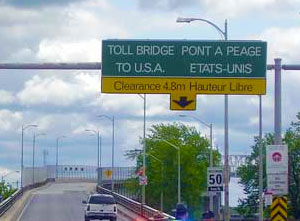Cross-border shopping boom ahead?
If Canada’s just-proposed federal budget passes as submitted, U.S. merchants could be big winners, and Canadian merchants could be in for real pain ahead.

International Bridge at Cornwall.
Why? Well, most Canadians live withing driving distance of the border. And Canadians love to shop abroad. A fair number of Canadians plan targeted shopping junkets, or make sure they pick up a few extra things on ordinary vacations or business trips abroad.
Since Canada’s population is one tenth that of the U.S., it stands to reason that selection and prices are often better in the states. But after a run of virtual parity between the two country’s currencies, Canadians are frustrated that they always seem to be paying more, no matter how strong the loonie is.
The old/current travel benchmarks can be found here.
As reported in the Vancouver Sun, the new rules would go like this:
Starting June 1, returning travelers who have been outside of Canada for more than 24 hours but less than 48 will be able to bring back $200 worth of tax-exempt goods. That’s up from $50. For those out of Canada for 48 hours or more, the exemption is also increasing from $400 to $800.
The exemption for more than seven days only rises by $50 to $800. Limits for alcohol and tobacco remain unchanged.
Or course, it’s hard to go on a quick shopping run and stay out of the country for more than 24 hours. So the changes won’t tempt everyone. But many would act to take advantage of possible savings. The Globe and Mail writes about who wins and who loses in this scenario:
“It’s going to have an impact,” said David Russell, co-owner of sporting goods and fashion chain Sporting Life. “People will spend more in the U.S. … That will take some money out of the hands of Canadian retailers.”
He said his hands are tied because he – and other Canadian retailers – are forced to pay up to 18 per cent higher import taxes on goods shipped to Canada from China and other overseas manufacturing centres compared with U.S. retailers.
“The government is tying my hands behind my back – I’m paying higher duties,” said Mr. Russell, who is also chairman of the retail council. “They’ve rendered me less competitive.”
Diane Brisebois, president of the Retail Council of Canada, echos that concern:
As well, retailers are charged up to 30 per cent more by U.S.-based global suppliers, such as Nike and Reebok, for the same products that they ship to their American counterparts, Ms. Brisebois said.
“Consumers have to understand that retailers are not gouging them,” she said. “There is not a level playing field.”
Finance Minister Jim Flaherty is no stranger to the emotions that surround this issue for consumers. As the Globe reports:
Mr. Flaherty has challenged businesses to explain their higher prices and asked the Senate national finance committee to study the price gap. “Canadians are rightly irritated when they see large price discrepancies on the exact same products being sold on different sides of the border,” Mr. Flaherty wrote to the committee in September. “I share their irritation.”
So, what’s your take? Is the playing field level? Seriously out of whack?
If you’re Canadian, do you believe in supporting local merchants? Or are you tired of constantly paying more?
If you’re a merchant on the U.S. side, will this change bring you more Canadian shoppers?
Lastly, if you’re a U.S. traveler, have higher prices and the stronger Canadian dollar reduced your trips to Canada?
Tags: border issues, canada, cross-border shopping, economy








International trade is a competition. Let’s extend our sales tax holiday so we can really turn up the heat.
This has happened before. In the past decade or so, $14 billion in retail sales were leaving Canada. At that point the Canadian government let the dollar devalue as low as $1.45-1.50 CDN to $1.00 and Canadian shoppers stayed home. US businesses certainly noticed the loss of Canadian shoppers. As a non-resident property owner in Ontario we certainly benefited from the cheaper Canadian dollar. At par, it takes more US dollars to pay for taxes, docking etc. We do tend to bring many items with us because often, even with a favorable exchange rate, the real cost is higher. Our Canadian friends certainly are frustrated about the price differentials. They tell stories of being able to buy items, often made in Canada for less in Watertown than they can at home.